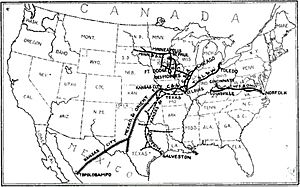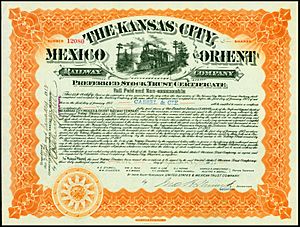Kansas City, Mexico and Orient Railway facts for kids
| Overview | |
|---|---|
| Locale | Mexico/United States |
| Dates of operation | 1900–1928 |
| Successor | Chihuahua al Pacífico/Atchison, Topeka and Santa Fe Railway |
| Technical | |
| Track gauge | 4 ft 8 1⁄2 in (1,435 mm) standard gauge |
| Length | R |
The Kansas City, Mexico and Orient Railway was a railroad company. It started in 1900. An American businessman named Arthur Edward Stilwell created it.
This railway was meant to connect Kansas City in the United States all the way to the Pacific Ocean. Its goal was to reach a port city called Topolobampo in Sinaloa, Mexico. It was a very ambitious plan!
Contents
Building the Orient Railway
The part of the railway in the United States began in 1900. It was built between Wichita, Kansas, and Alpine, Texas. Workers also prepared the ground for tracks in other areas.
The main repair shops for the trains were first in Fairview, Oklahoma. But in 1910, a fire destroyed these shops. So, they moved the shops to Wichita.
Challenges and Changes
The railway faced money problems. In 1912, it went bankrupt. This means it ran out of money to operate. A person called William T. Kemper was put in charge to manage the company.
Luckily for the railway, oil was discovered under its tracks! This helped the company get back on its feet. In 1914, the railway was reorganized. It was given a new name: the KCM&O Railroad. Later, in 1925, it went back to its original name. People often called it simply The Orient railroad.
The Railway's Reach and Sale
By the end of 1925, the Kansas City, Mexico and Orient Railway was quite large. It had about 859 kilometers (534 miles) of track. This track covered about 738 kilometers (459 miles) of land.
The railway moved a lot of goods and people. It carried millions of tons of freight. It also transported millions of passengers.
Joining the Santa Fe Railway
In 1928, a much larger railway company bought the KCM&O. This was the Atchison, Topeka and Santa Fe Railway. The Santa Fe company bought it mainly to get access to the new oil fields in West Texas.
After the purchase, the Santa Fe company sold the parts of the railway that were in Mexico. In 1930, the railway reached Presidio, Texas. A special bridge for trains was built there. This bridge connected Presidio to Ojinaga in Mexico.
Later, another company called Texas Pacifico Transportation got the right to use some of the tracks. These tracks ran from near San Angelo, Texas to Presidio.



